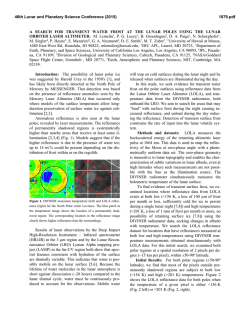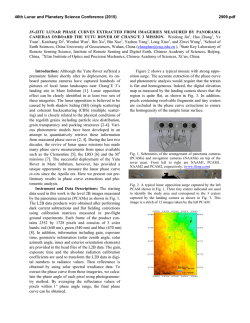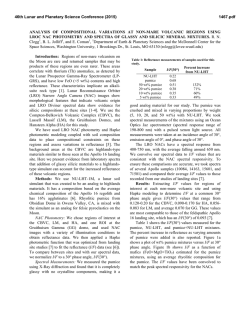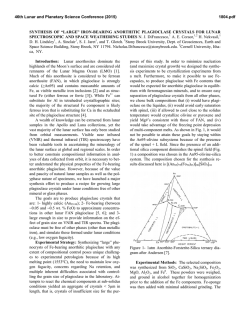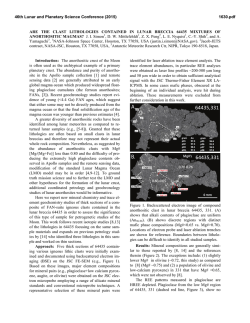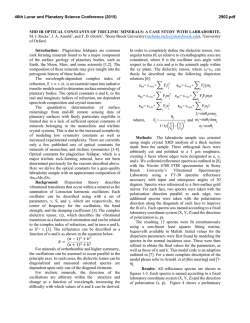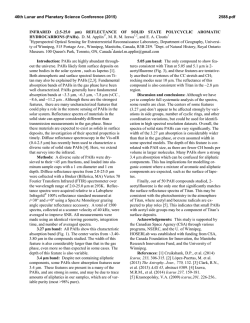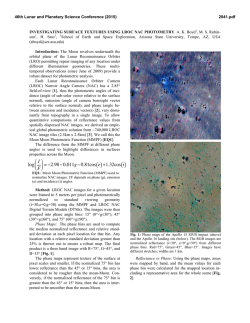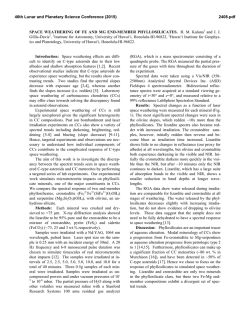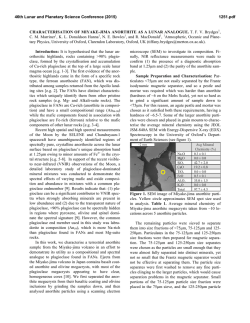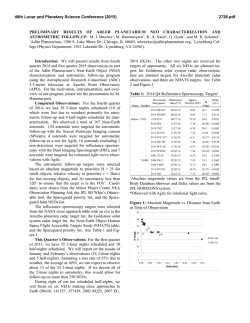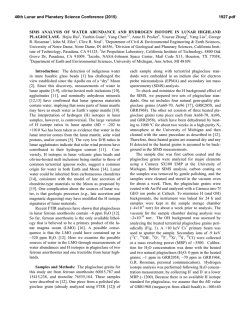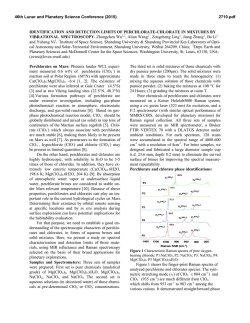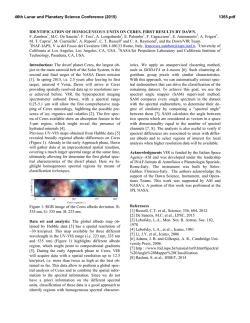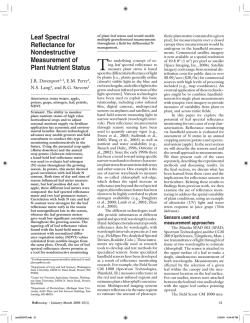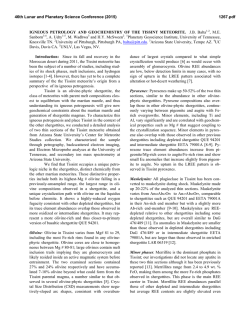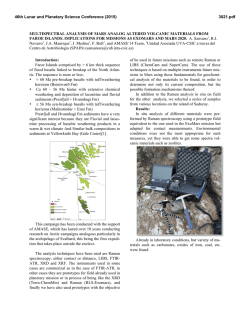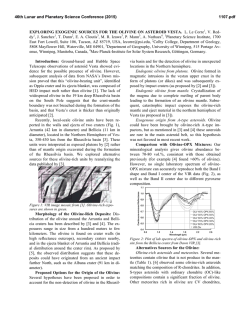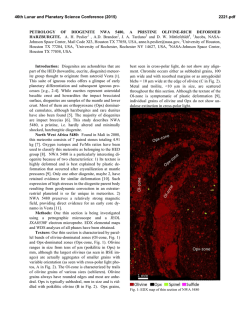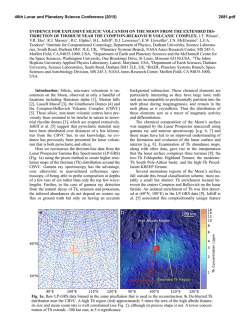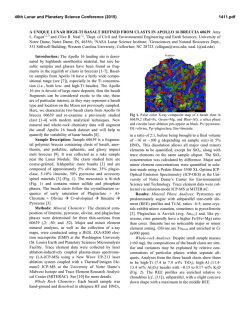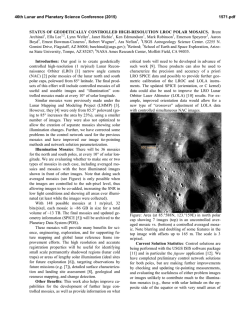
Temperature Effects on the Reflectance Spectra of Olivine and
46th Lunar and Planetary Science Conference (2015) 2858.pdf TEMPERATURE EFFECTS ON THE REFLECTANCE SPECTRA OF OLIVINE AND PLAGIOCLASE. L. M. Corley1 and J. J. Gillis-Davis1, 1Hawai‘i Institute of Geophysics and Planetology, University of Hawaiʻi at Mānoa, 1680 East-West Road, Honolulu, HI 96822, USA ([email protected]). Introduction: The spectral properties of minerals may vary with temperature, likely caused by changes in the interatomic spacing and the crystal field. A series of laboratory experiments by Roush and Singer showed that the width, area, and placement of absorption bands in mafic silicates may change in relation to temperature [1, 2, 3]. Hinrichs and Lucey [4] quantified the dependence of spectral properties on temperature for mafic minerals, lunar soils, and meteorites. For mafic minerals, they showed that the absorption bands broaden and the 2-µm absorption band of orthopyroxene shifts to longer wavelengths with increasing temperature. In addition, the reflectance of pyroxene at 1,050 nm increases with decreasing temperature. The importance for considering surface temperature in remotely sensed data is underscored by reflectance measurements made by the Lunar Orbiter Laser Altimeter (LOLA) [5, 6] and the Mercury Laser Altimeter (MLA) [7]. LOLA measured a spike in brightness at 1,064 nm in permanently shadowed regions (PSRs). Suggested causes were water ice, mass wasting, or reduced space weathering [5]. In addition, there is a clear antircorrelation trend between temperature and reflectance in LOLA data [8]. Lucey et al. [8] hypothesized that the trend is due to an influence of temperature on space weathering. Previous laboratory experiments [4] have shown that the overall effect of temperature on the spectral properties of lunar soils is minute, though measurable. The maximum change in relative reflectance with temperature is on the order of 1% or less per 100 K, compared to about 5–10% for the ordinary chondrites and HEDs and up to 35% for pure minerals [4]. This minute reflectance change is not enough to explain the brightness increase observed in the LOLA data. It was proposed that space weathering masked the temperature effect on spectral properties [4]. Hence we aim to test this hypothesis by measuring reflectance dependent changes of plagioclase as a function of temperature and laser space weathering using a thermally controlled chamber. Our experimental setup is guided by hypothesis that the lower surface temperatures of the polar regions and the extremely low temperatures in PSRs (as low as 50 K) affect the melting and development of SMFe, particularly in the presence of potential volatiles. Such effects could influence the spectral reflectance of the materials within PSRs. Hence a decrease in the production of SMFe would reduce the ability of space weathering to mask the temperature effect on spectral properties. We began this investigation by first examining the effect of temperature on olivine and plagioclase. Methods: We collected spectra of powdered San Carlos olivine (<150 µm) and Stillwater plagioclase (<75 µm) at varying temperatures. Samples were placed in the same thermal vacuum chamber used by [4], which controls the radiation environment on the sample using liquid nitrogen for cooling (Fig. 1). A vacuum pressure of 1-2×10-6 torr was achieved using Pfeiffer Hi-cube oil-free turbo and roughing pump combination. Figure 1: Experimental setup, with the light and optics shown in the position for measuring reflectance of a Spectralon standard. Olivine was used in an attempt to reproduce the results of [4]. Plagioclase spectra were measured in order to determine if plagioclase exhibits similar spectral dependence on temperature as mafic minerals. Hinrichs and Lucey [4] did not measure the thermoreflectance spectrum of plagioclase. Work by Roush [1] suggests that the spectrum of plagioclase is relatively inactive with respect to temperature. However, in his experimental setup the radiative environment was not controlled nor documented sufficiently to model the influence of radiation. Furthermore, the true thermodynamic temperature of the sample’s optical surface is uncertain. The temperature-controlled chamber was shown by [4] to effectively act as a blackbody cavity. A Lake Shore Cryotonics Inc. Model 321 Autotuning Temperature Controller recorded the temperatures measured with silicon diode temperature sensors mounted inside the chamber. Spectra were collected at temperatures varied between ambient temperature and 90 K. Hin- 46th Lunar and Planetary Science Conference (2015) richs and Lucey estimated that their measurements were limited to a minimum temperature of 150 K from radiative heating of the sample by the light source. Reflectance measurements were taken with Analytical Spectral Devices Inc. (ASD) FieldSpec® FR Spectrometer, which measures reflectance from the UVVIS to NIR (0.35-2.5 µm) with a full-width-half-max spectral resolution of 3 nm for 1000 nm and 10 nm for 1000-2500 nm. The windows in the chamber are situated such that the incidence and emissions angles are 10.5° and the phase angle is 21.0°. Reflectance was measured relative to Spectralon standards at ambient temperature. For olivine, we used the 20% and 40% reflectance standards to bracket the average reflectance. The 40% and 60% reflectance standards were used to bracket the average reflectance of plagioclase. Results: Measurements of olivine spectra show a broadening of the 1-µm absorption band with increasing temperature consistent with the experimental results of [1,2,3,4] (Fig. 2). Reflectance measurements of plagioclase exhibit increased brightness with decreasing temperature (Fig. 3). 0.55 Absolute Reflectance 0.5 0.45 0.4 0.35 293 K 250 K 100 K 90 K 0.3 0.25 0.2 500 1000 1500 2000 Wavelength (nm) Figure 2: Absolute reflectance spectra of San Carlos olivine at ambient temperature (red), 250 K (black), 100 K (green), and 90 K (blue). Absolute Reflectance 0.65 0.6 0.55 230 K 200 K 0.5 170 K 125 K 0.45 100 K 90 K 0.4 400 600 800 1000 1200 1400 Wavelength (nm) 1600 1800 2000 Figure 3: Absolute reflectance spectra of Stillwater plagioclase at 230 K (red), 200 K (orange), 170 K (black), 125 K (green), 100 K (blue), and 90 K (purple). 2858.pdf Discussion: Reflectance measurements of plagioclase in a temperature-controlled vacuum chamber show an inverse correlation with temperature. Increased brightness was observed at temperatures comparable to average temperatures [6] of PSRs on the Moon and Mercury. However, in lunar soils this temperature effect may be masked by the darkening effect of space weathering [4]. Nevertheless, surface temperature must be considered for mineralogical interpretation of remotely obtained spectral reflectance data such as LOLA and MLA. Future Work: The goal of future experiments is to understand the factors and their relative proportions that contribute to increased reflectance at 1,064 nm as measured by LOLA and MLA. We will first expand our experiments to pure pyroxene and a mixture of plagioclase, pyroxene, and olivine as an immature highlands regolith analog. We will also add 3 wt.% iron metal to plagioclase in order to simulate meteoritic iron [9]. Another set of experiments will aim to determine the effects of space weathering at low temperatures. We will perform laser induced space weathering experiments inside the thermal vacuum chamber at ~80 K. Analyses will include reflectance measurements, measurements of the volatiles released from the samples, and examination of any submicroscopic iron and glassy patinas produced using transmission electron microscopy. The space weathering experiments will help test the hypothesis of [8] that a temperatureinduced reduction in the effectiveness of space weathering contributes to the increased reflectivity of PSRs. References: [1] Roush T. L. (1984) , Effects of temperature on remotely sensed mafic mineral absorption features, Master’s Thesis, University of Hawaii. [2] Singer R. B. and Roush T. L. (1985) JGR, 90, B14, 12434-12444. [3] Roush T. L. and R. B. Singer (1986) JGR. 91, B10, 10301-10308. [4] Hinrichs J. L. and Lucey P. G. (2002) Icarus, 155, 169-180. [5] Zuber M. T. et al. (2012) Nature, 486(7403), 378-381. [6] Paige D. A. et al. (2013) AGU, Abstract P11A-03. [7] Neuman et al. (2013) Science, 339, 296-300. [8] Lucey P. G. et al. (2014) JGR, 119, 1665-1679. [9] McKay D. S. et al. (1991) in The Lunar Sourcebook, 285-356, Cambridge Univ. Press, New York.
© Copyright 2025
